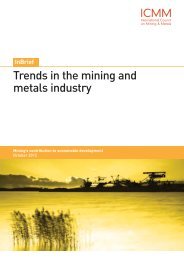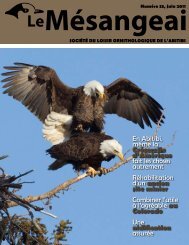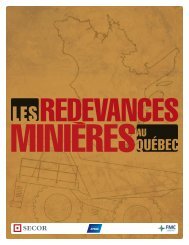You also want an ePaper? Increase the reach of your titles
YUMPU automatically turns print PDFs into web optimized ePapers that Google loves.
Reported reserves<br />
Gold Platinum Copper Zinc Nickel Iron ore<br />
Metallurgical<br />
Coal<br />
<strong>The</strong>rmal<br />
Coal<br />
Bauxite<br />
Potash<br />
(million oz)<br />
(million tonnes)<br />
No. of<br />
companies<br />
15 5 19 7 5 7 12 12 3 2<br />
2009 reserves 582 211 271 40 19 14,939 11,449 67,822 1,177 746<br />
(Depletion) (34) (4) (7) (3) (1) (716) (226) (1,273) (40) (13)<br />
Other net<br />
addition/<br />
(reduction)<br />
71 3 36 3 - 1,278 336 831 (31) 25<br />
2010 reserves 619 210 300 40 18 15,501 11,559 67,380 1,106 758<br />
Change (%) 6% (1%) 11% 0% (4%) 4% 1% (1%) (6%) 2%<br />
Remaining life<br />
(years)<br />
18 51 41 12 21 22 51 53 27 57<br />
Successful conversion<br />
In some commodities mine life was extended in 2010, but<br />
overall our analysis shows that on a copper equivalent<br />
tonnes basis, the industry’s remaining mine life decreased<br />
by two years to 35. This demonstrates that while the Top<br />
40 experienced exploration success, it was not as much as<br />
the increase in production during the year.<br />
Gold exploration gains<br />
PwC’s annual Global Gold Price survey for 2010 again<br />
highlighted the use of higher gold prices in reserve<br />
calculations which lead to lower gold cut-off grades. <strong>The</strong><br />
average gold price used in the calculation increased from<br />
$974 per ounce in 2009 to $1,227 per ounce in 2010. <strong>The</strong><br />
surging gold prices have made higher cost mines<br />
economically feasible. Furthermore, successful<br />
exploration results throughout the year have also pushed<br />
gold reserves higher, such as the gold contained at Oyu<br />
Tolgoi in Mongolia, Goldcorp’s South American and<br />
Canadian projects and Kinross’ projects in Mauritania<br />
and South America.<br />
Copper in focus<br />
Increasing long-term price assumptions following the<br />
run up in the copper price fueled a uniform increase in<br />
copper reserves across the Top 40. <strong>The</strong> increased copper<br />
reserves were primarily attributable to Ivanhoe and Rio<br />
Tinto’s massive Oyu Tolgoi project in Mongolia as well as<br />
Freeport McMoRan’s addition of copper reserves at its<br />
North American properties. New reserves have<br />
significantly exceeded depletion of ore as production was<br />
down, resulting in an extension of the life of the copper<br />
mines by about eight years over 2009.<br />
Pressure on zinc and nickel<br />
Zinc and nickel reserves remained at about 2009 levels<br />
as exploration programs have not discovered significant<br />
new ore bodies in the last few years. <strong>The</strong> remaining zinc<br />
life of Top 40 companies <strong>has</strong> decreased from 13 years at<br />
the end of 2009 to 12 years and nickel <strong>has</strong> declined to 21<br />
years – the shortest remaining lives of all commodities.<br />
We note that a number of major zinc producers are not<br />
currently included in the Top 40, such as Vedanta<br />
Resources plc and Minmetals Resources Limited.<br />
Pay dirt<br />
<strong>The</strong> huge iron ore investments by the majors in<br />
expanding their operations to meet ever growing<br />
demand <strong>has</strong> hit pay dirt in 2010 with a significant<br />
increase in reserves leading to overall growth in<br />
remaining mine life to 22 years. Significant additions<br />
were recorded by all major iron ore players.<br />
<strong>Mine</strong>–<strong>The</strong> <strong>game</strong> <strong>has</strong> <strong>changed</strong> 31









